Home / Grignard Reagents For Addition To Aldehydes and Ketones
Aldehydes and Ketones
Grignard Reagents For Addition To Aldehydes and Ketones
Last updated: March 21st, 2025 |
Grignard Reagents: Their Formation, Reactions, And Reaction Mechanisms

Today’s reagent is one that most students have experience in making at some point or another. Grignard reagents are formed by the reaction of magnesium metal with alkyl or alkenyl halides. They’re extremely good nucleophiles, reacting with electrophiles such as carbonyl compounds (aldehydes, ketones, esters, carbon dioxide, etc) and epoxides. They’re also very strong bases and will react with acidic hydrogens (such as alcohols, water, and carboxylic acids). Similar to or the same as: very similar to organolithium reagents.
Table of Contents
-
- Formation Of Grignard Reagents
- Reaction Of Grignard Reagents With Aldehydes To Give Secondary Alcohols
- Reaction Of Grignard Reagents With Ketones To Give Tertiary Alcohols
- Grignards Add Twice To Esters And Acid Halides
- Addition Of Grignard Reagents To Epoxides
- Reaction Of Grignard Reagents With Carbon Dioxide To Give Carboxylic Acids
- Grignard Reagents Are Strong Bases – Protonation (And Deuteration)
- Mechanism: Addition Of Grignard Reagents To Aldehydes And Ketones
- Notes
- Quiz Yourself!
- (Advanced) References and Further Reading
1. Formation Of Grignard Reagents
Grignard reagents are made through the addition of magnesium metal to alkyl or alkenyl halides. The halide can be Cl, Br, or I (not F). It’s slightly easier to make Grignards from the iodides and bromides, however. Note what’s happening here – the magnesium is “inserting” itself between the carbon and the halide. This halide the “X” referred to when we refer to Grignard reagents as “RMgX”.
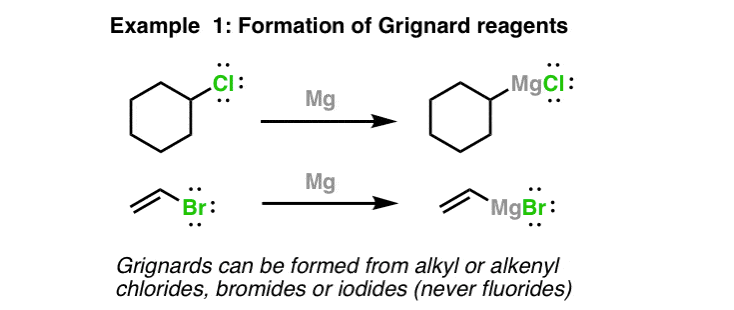
2. Reaction Of Grignard Reagents With Aldehydes To Give Secondary Alcohols
One of the most common uses of Grignard reagents is in their reaction with aldehydes and ketones to form alcohols. In the first step, the Grignard forms the carbon-carbon bond. This results in an alkoxide (the conjugate base of an alcohol). To form the alcohol, it’s necessary to add acid at the end of the reaction (in what’s called the “workup” step). This is shown here as “H3O+” (the “X” is just the counter-ion, a spectator here)
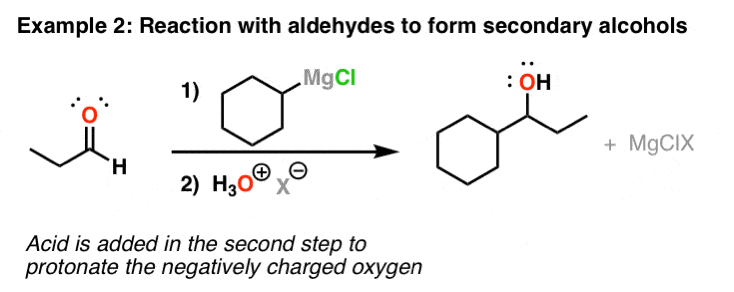
3. Reaction Of Grignard Reagents With Ketones To Give Tertiary Alcohols
The reaction behaves similarly with ketones. Again, there’s nothing special about the Cl here – it all depends on how you made the Grignard in the first place.

4. Grignards Add Twice To Esters And Acid Halides
Grignard reagents will also add to esters. What makes these reactions a little more complicated is that they add twice. The net result (after addition of acid) is a tertiary alcohol. This is also the case for acid halides (acyl halides) and anhydrides. One notable exception is carboxylic acids (more on that below).
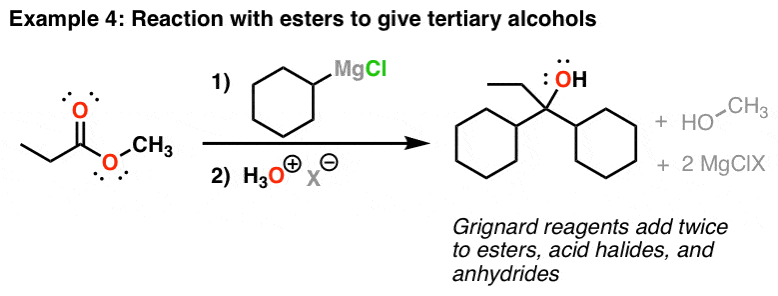
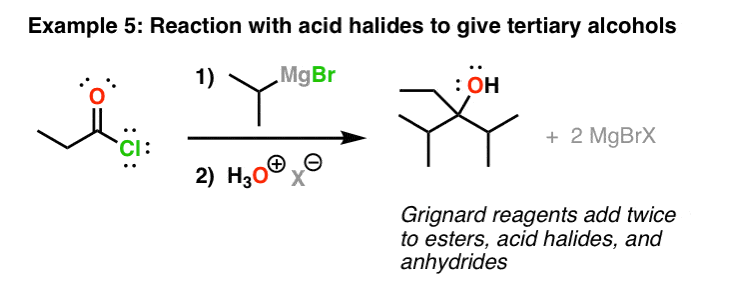
5. Addition Of Grignard Reagents To Epoxides
Another important reaction of Grignard reagents is that they will add to epoxides to form carbon-carbon bonds. One thing to keep in mind here is that the tendency is for them to add to the less substituted end of the epoxide – that is, the less sterically hindered end. You can think of this reaction as being essentially similar to an SN2 reaction. After addition of acid, an alcohol is obtained.
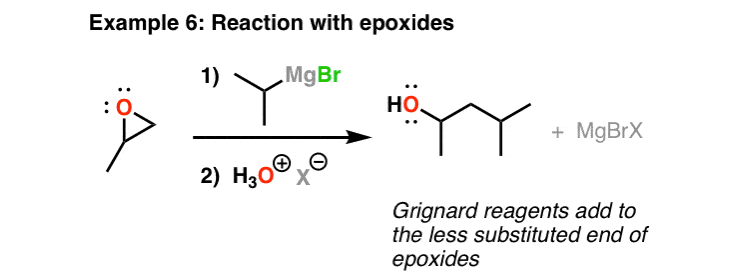
6. Reaction Of Grignard Reagents With Carbon Dioxide To Give Carboxylic Acids
Grignard reagents also add to carbon dioxide (CO2) to form carboxylates, in a reaction similar to their reactions with ketones and aldehydes. The carboxylates are converted to carboxylic acids after addition of acid (such as our trusty H3O(+) ).

7. Grignard Reagents Are Strong Bases – Protonation (And Deuteration)
Finally, since Grignard reagents are essentially the conjugate bases of alkanes, they’re also extremely strong bases. This means that sometimes acid-base reactions can compete with their nucleophilic addition reactions. One common situation where this crops up is when Grignard reagents are added to carboxylic acids. It’s easy to forget that carboxylic acids… are acids. This means that instead of adding to the carbonyl, they react with the proton instead and form the carboxylate salt.
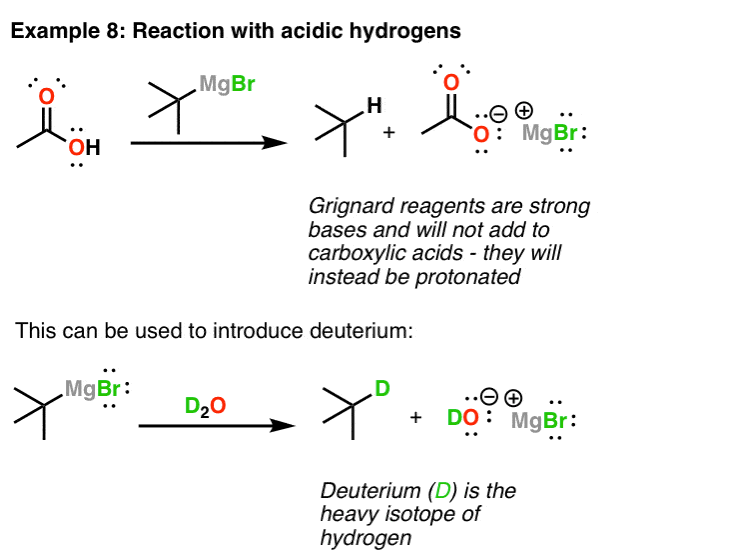
This can also be used to convert alkyl halides to alkanes. First you treat it with magnesium, and then you treat the Grignard with a strong acid. This gives you the alkane. You can also use this to introduce deuterium (D) into molecules! The first step is to make the Grignard reagent. The second is to treat that Grignard with a deuterated acid such as D2O. This gives you the deuterated alkane!
8. Mechanism: Addition Of Grignard Reagents To Aldehydes And Ketones
So how does it work? The key to the Grignard reagent is actually very simple. When you think about the relative electronegativities of carbon (2.5) and magnesium (1.1), the bond between carbon and magnesium is polarized toward carbon. That means that carbon is more electron rich than magnesium and is actually nucleophilic! Here’s a closer look.
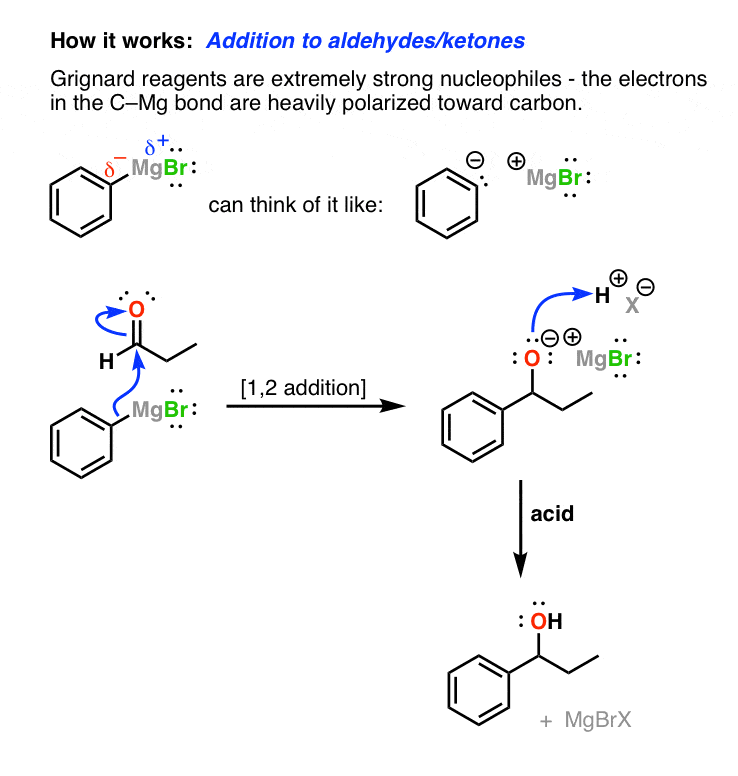
In the reaction of Grignards with aldehydes, the carbon attacks the carbonyl carbon and performs a 1,2-addition to give an alkoxide. In the second step, acid is added to give you the alcohol.
Notes
Quiz Yourself!
[quizzes]
(Advanced) References and Further Reading
- Grignard, V. C. Acad. Sci. 1900, 130, 1322-1324
The original paper by Victor Grignard describing a new method for alcohol synthesis from hydrocarbons. - Victor Grignard and Paul Sabatier: Two Showcase Laureates of the Nobel Prize for Chemistry
Henri B. Kagan
Chem. Int. Ed. 2012, 51, 2-9
DOI: 10.1002/anie.201201849
For those interested in the history of science, this is a historical perspective on the lives of Victor Grignard and Paul Sabatier, and gives insight into their lives, how they made their seminal discoveries, and the impact of their work, among other things. - Mechanical activation of magnesium turnings for the preparation of reactive Grignard reagents
Karen V. Baker, John M. Brown, Nigel Hughes, A. Jerome Skarnulis, and Ann Sexton
The Journal of Organic Chemistry 1991 56 (2), 698-703
DOI: 10.1021/jo00002a039
Sometimes the formation of a Grignard reagent using Mg metal can be challenging, and various methods for activating the metal surface have been developed, including mechanical activation by dry-stirring Mg turnings under an inert atmosphere for several hours.
The following 3 papers are mechanistic studies on the formation of Grignard reagents: - The Mechanism of Formation of Grignard Reagents: Trapping of Free Alkyl Radical Intermediates by Reaction with Tetramethylpiperidine-N-oxyl
Karen S. Root, Craig L. Hill, Lynette M. Lawrence, and George M. Whitesides
Journal of the American Chemical Society 1989 111 (14), 5405-5412
DOI: 10.1021/ja00196a053 - Mechanism of Grignard Reagent Formation. The Surface Nature of the Reaction
M. Walborsky and Janusz Rachon
Journal of the American Chemical Society 1989 111 (5), 1896-1897
DOI: 10.1021/ja00187a063 - Mechanism of Grignard Reagent Formation. Comparisons of D-Model Calculations with Experimental Product Yields
John F. Garst and Brian L. Swift
Journal of the American Chemical Society 1989 111 (1), 241-250
DOI: 10.1021/ja00183a037 - 4-METHOXY-4′-NITROBIPHENYL
K. Stille, Antonio M. Echavarren, Robert M. Williams, and James A. Hendrix
Org. Synth. 1993, 71, 97
DOI: 10.15227/orgsyn.071.0097
The second step in this procedure includes the synthesis of p-anisylmagnesium bromide, which can be a tricky Grignard reagent to prepare and requires special activation of Mg with methyl iodide.
00 General Chemistry Review
01 Bonding, Structure, and Resonance
- How Do We Know Methane (CH4) Is Tetrahedral?
- Hybrid Orbitals and Hybridization
- How To Determine Hybridization: A Shortcut
- Orbital Hybridization And Bond Strengths
- Sigma bonds come in six varieties: Pi bonds come in one
- A Key Skill: How to Calculate Formal Charge
- The Four Intermolecular Forces and How They Affect Boiling Points
- 3 Trends That Affect Boiling Points
- How To Use Electronegativity To Determine Electron Density (and why NOT to trust formal charge)
- Introduction to Resonance
- How To Use Curved Arrows To Interchange Resonance Forms
- Evaluating Resonance Forms (1) - The Rule of Least Charges
- How To Find The Best Resonance Structure By Applying Electronegativity
- Evaluating Resonance Structures With Negative Charges
- Evaluating Resonance Structures With Positive Charge
- Exploring Resonance: Pi-Donation
- Exploring Resonance: Pi-acceptors
- In Summary: Evaluating Resonance Structures
- Drawing Resonance Structures: 3 Common Mistakes To Avoid
- How to apply electronegativity and resonance to understand reactivity
- Bond Hybridization Practice
- Structure and Bonding Practice Quizzes
- Resonance Structures Practice
02 Acid Base Reactions
- Introduction to Acid-Base Reactions
- Acid Base Reactions In Organic Chemistry
- The Stronger The Acid, The Weaker The Conjugate Base
- Walkthrough of Acid-Base Reactions (3) - Acidity Trends
- Five Key Factors That Influence Acidity
- Acid-Base Reactions: Introducing Ka and pKa
- How to Use a pKa Table
- The pKa Table Is Your Friend
- A Handy Rule of Thumb for Acid-Base Reactions
- Acid Base Reactions Are Fast
- pKa Values Span 60 Orders Of Magnitude
- How Protonation and Deprotonation Affect Reactivity
- Acid Base Practice Problems
03 Alkanes and Nomenclature
- Meet the (Most Important) Functional Groups
- Condensed Formulas: Deciphering What the Brackets Mean
- Hidden Hydrogens, Hidden Lone Pairs, Hidden Counterions
- Don't Be Futyl, Learn The Butyls
- Primary, Secondary, Tertiary, Quaternary In Organic Chemistry
- Branching, and Its Affect On Melting and Boiling Points
- The Many, Many Ways of Drawing Butane
- Wedge And Dash Convention For Tetrahedral Carbon
- Common Mistakes in Organic Chemistry: Pentavalent Carbon
- Table of Functional Group Priorities for Nomenclature
- Summary Sheet - Alkane Nomenclature
- Organic Chemistry IUPAC Nomenclature Demystified With A Simple Puzzle Piece Approach
- Boiling Point Quizzes
- Organic Chemistry Nomenclature Quizzes
04 Conformations and Cycloalkanes
- Staggered vs Eclipsed Conformations of Ethane
- Conformational Isomers of Propane
- Newman Projection of Butane (and Gauche Conformation)
- Introduction to Cycloalkanes
- Geometric Isomers In Small Rings: Cis And Trans Cycloalkanes
- Calculation of Ring Strain In Cycloalkanes
- Cycloalkanes - Ring Strain In Cyclopropane And Cyclobutane
- Cyclohexane Conformations
- Cyclohexane Chair Conformation: An Aerial Tour
- How To Draw The Cyclohexane Chair Conformation
- The Cyclohexane Chair Flip
- The Cyclohexane Chair Flip - Energy Diagram
- Substituted Cyclohexanes - Axial vs Equatorial
- Ranking The Bulkiness Of Substituents On Cyclohexanes: "A-Values"
- Cyclohexane Chair Conformation Stability: Which One Is Lower Energy?
- Fused Rings - Cis-Decalin and Trans-Decalin
- Naming Bicyclic Compounds - Fused, Bridged, and Spiro
- Bredt's Rule (And Summary of Cycloalkanes)
- Newman Projection Practice
- Cycloalkanes Practice Problems
05 A Primer On Organic Reactions
- The Most Important Question To Ask When Learning a New Reaction
- Curved Arrows (for reactions)
- Nucleophiles and Electrophiles
- The Three Classes of Nucleophiles
- Nucleophilicity vs. Basicity
- What Makes A Good Nucleophile?
- What Makes A Good Leaving Group?
- 3 Factors That Stabilize Carbocations
- Equilibrium and Energy Relationships
- 7 Factors that stabilize negative charge in organic chemistry
- 7 Factors That Stabilize Positive Charge in Organic Chemistry
- What's a Transition State?
- Hammond's Postulate
- Learning Organic Chemistry Reactions: A Checklist (PDF)
- Introduction to Oxidative Cleavage Reactions
06 Free Radical Reactions
- Bond Dissociation Energies = Homolytic Cleavage
- Free Radical Reactions
- 3 Factors That Stabilize Free Radicals
- What Factors Destabilize Free Radicals?
- Bond Strengths And Radical Stability
- Free Radical Initiation: Why Is "Light" Or "Heat" Required?
- Initiation, Propagation, Termination
- Monochlorination Products Of Propane, Pentane, And Other Alkanes
- Selectivity In Free Radical Reactions
- Selectivity in Free Radical Reactions: Bromination vs. Chlorination
- Halogenation At Tiffany's
- Allylic Bromination
- Bonus Topic: Allylic Rearrangements
- In Summary: Free Radicals
- Synthesis (2) - Reactions of Alkanes
- Free Radicals Practice Quizzes
07 Stereochemistry and Chirality
- Types of Isomers: Constitutional Isomers, Stereoisomers, Enantiomers, and Diastereomers
- How To Draw The Enantiomer Of A Chiral Molecule
- How To Draw A Bond Rotation
- Introduction to Assigning (R) and (S): The Cahn-Ingold-Prelog Rules
- Assigning Cahn-Ingold-Prelog (CIP) Priorities (2) - The Method of Dots
- Enantiomers vs Diastereomers vs The Same? Two Methods For Solving Problems
- Assigning R/S To Newman Projections (And Converting Newman To Line Diagrams)
- How To Determine R and S Configurations On A Fischer Projection
- The Meso Trap
- Optical Rotation, Optical Activity, and Specific Rotation
- Optical Purity and Enantiomeric Excess
- What's a Racemic Mixture?
- Chiral Allenes And Chiral Axes
- Stereochemistry Practice Problems and Quizzes
08 Substitution Reactions
- Nucleophilic Substitution Reactions - Introduction
- Two Types of Nucleophilic Substitution Reactions
- The SN2 Mechanism
- Why the SN2 Reaction Is Powerful
- The SN1 Mechanism
- The Conjugate Acid Is A Better Leaving Group
- Comparing the SN1 and SN2 Reactions
- Polar Protic? Polar Aprotic? Nonpolar? All About Solvents
- Steric Hindrance is Like a Fat Goalie
- Common Blind Spot: Intramolecular Reactions
- Substitution Practice - SN1
- Substitution Practice - SN2
09 Elimination Reactions
- Elimination Reactions (1): Introduction And The Key Pattern
- Elimination Reactions (2): The Zaitsev Rule
- Elimination Reactions Are Favored By Heat
- Two Elimination Reaction Patterns
- The E1 Reaction
- The E2 Mechanism
- E1 vs E2: Comparing the E1 and E2 Reactions
- Antiperiplanar Relationships: The E2 Reaction and Cyclohexane Rings
- Bulky Bases in Elimination Reactions
- Comparing the E1 vs SN1 Reactions
- Elimination (E1) Reactions With Rearrangements
- E1cB - Elimination (Unimolecular) Conjugate Base
- Elimination (E1) Practice Problems And Solutions
- Elimination (E2) Practice Problems and Solutions
10 Rearrangements
11 SN1/SN2/E1/E2 Decision
- Identifying Where Substitution and Elimination Reactions Happen
- Deciding SN1/SN2/E1/E2 (1) - The Substrate
- Deciding SN1/SN2/E1/E2 (2) - The Nucleophile/Base
- SN1 vs E1 and SN2 vs E2 : The Temperature
- Deciding SN1/SN2/E1/E2 - The Solvent
- Wrapup: The Key Factors For Determining SN1/SN2/E1/E2
- Alkyl Halide Reaction Map And Summary
- SN1 SN2 E1 E2 Practice Problems
12 Alkene Reactions
- E and Z Notation For Alkenes (+ Cis/Trans)
- Alkene Stability
- Alkene Addition Reactions: "Regioselectivity" and "Stereoselectivity" (Syn/Anti)
- Stereoselective and Stereospecific Reactions
- Hydrohalogenation of Alkenes and Markovnikov's Rule
- Hydration of Alkenes With Aqueous Acid
- Rearrangements in Alkene Addition Reactions
- Halogenation of Alkenes and Halohydrin Formation
- Oxymercuration Demercuration of Alkenes
- Hydroboration Oxidation of Alkenes
- m-CPBA (meta-chloroperoxybenzoic acid)
- OsO4 (Osmium Tetroxide) for Dihydroxylation of Alkenes
- Palladium on Carbon (Pd/C) for Catalytic Hydrogenation of Alkenes
- Cyclopropanation of Alkenes
- A Fourth Alkene Addition Pattern - Free Radical Addition
- Alkene Reactions: Ozonolysis
- Summary: Three Key Families Of Alkene Reaction Mechanisms
- Synthesis (4) - Alkene Reaction Map, Including Alkyl Halide Reactions
- Alkene Reactions Practice Problems
13 Alkyne Reactions
- Acetylides from Alkynes, And Substitution Reactions of Acetylides
- Partial Reduction of Alkynes With Lindlar's Catalyst
- Partial Reduction of Alkynes With Na/NH3 To Obtain Trans Alkenes
- Alkyne Hydroboration With "R2BH"
- Hydration and Oxymercuration of Alkynes
- Hydrohalogenation of Alkynes
- Alkyne Halogenation: Bromination, Chlorination, and Iodination of Alkynes
- Alkyne Reactions - The "Concerted" Pathway
- Alkenes To Alkynes Via Halogenation And Elimination Reactions
- Alkynes Are A Blank Canvas
- Synthesis (5) - Reactions of Alkynes
- Alkyne Reactions Practice Problems With Answers
14 Alcohols, Epoxides and Ethers
- Alcohols - Nomenclature and Properties
- Alcohols Can Act As Acids Or Bases (And Why It Matters)
- Alcohols - Acidity and Basicity
- The Williamson Ether Synthesis
- Ethers From Alkenes, Tertiary Alkyl Halides and Alkoxymercuration
- Alcohols To Ethers via Acid Catalysis
- Cleavage Of Ethers With Acid
- Epoxides - The Outlier Of The Ether Family
- Opening of Epoxides With Acid
- Epoxide Ring Opening With Base
- Making Alkyl Halides From Alcohols
- Tosylates And Mesylates
- PBr3 and SOCl2
- Elimination Reactions of Alcohols
- Elimination of Alcohols To Alkenes With POCl3
- Alcohol Oxidation: "Strong" and "Weak" Oxidants
- Demystifying The Mechanisms of Alcohol Oxidations
- Protecting Groups For Alcohols
- Thiols And Thioethers
- Calculating the oxidation state of a carbon
- Oxidation and Reduction in Organic Chemistry
- Oxidation Ladders
- SOCl2 Mechanism For Alcohols To Alkyl Halides: SN2 versus SNi
- Alcohol Reactions Roadmap (PDF)
- Alcohol Reaction Practice Problems
- Epoxide Reaction Quizzes
- Oxidation and Reduction Practice Quizzes
15 Organometallics
- What's An Organometallic?
- Formation of Grignard and Organolithium Reagents
- Organometallics Are Strong Bases
- Reactions of Grignard Reagents
- Protecting Groups In Grignard Reactions
- Synthesis Problems Involving Grignard Reagents
- Grignard Reactions And Synthesis (2)
- Organocuprates (Gilman Reagents): How They're Made
- Gilman Reagents (Organocuprates): What They're Used For
- The Heck, Suzuki, and Olefin Metathesis Reactions (And Why They Don't Belong In Most Introductory Organic Chemistry Courses)
- Reaction Map: Reactions of Organometallics
- Grignard Practice Problems
16 Spectroscopy
- Degrees of Unsaturation (or IHD, Index of Hydrogen Deficiency)
- Conjugation And Color (+ How Bleach Works)
- Introduction To UV-Vis Spectroscopy
- UV-Vis Spectroscopy: Absorbance of Carbonyls
- UV-Vis Spectroscopy: Practice Questions
- Bond Vibrations, Infrared Spectroscopy, and the "Ball and Spring" Model
- Infrared Spectroscopy: A Quick Primer On Interpreting Spectra
- IR Spectroscopy: 4 Practice Problems
- 1H NMR: How Many Signals?
- Homotopic, Enantiotopic, Diastereotopic
- Diastereotopic Protons in 1H NMR Spectroscopy: Examples
- 13-C NMR - How Many Signals
- Liquid Gold: Pheromones In Doe Urine
- Natural Product Isolation (1) - Extraction
- Natural Product Isolation (2) - Purification Techniques, An Overview
- Structure Determination Case Study: Deer Tarsal Gland Pheromone
17 Dienes and MO Theory
- What To Expect In Organic Chemistry 2
- Are these molecules conjugated?
- Conjugation And Resonance In Organic Chemistry
- Bonding And Antibonding Pi Orbitals
- Molecular Orbitals of The Allyl Cation, Allyl Radical, and Allyl Anion
- Pi Molecular Orbitals of Butadiene
- Reactions of Dienes: 1,2 and 1,4 Addition
- Thermodynamic and Kinetic Products
- More On 1,2 and 1,4 Additions To Dienes
- s-cis and s-trans
- The Diels-Alder Reaction
- Cyclic Dienes and Dienophiles in the Diels-Alder Reaction
- Stereochemistry of the Diels-Alder Reaction
- Exo vs Endo Products In The Diels Alder: How To Tell Them Apart
- HOMO and LUMO In the Diels Alder Reaction
- Why Are Endo vs Exo Products Favored in the Diels-Alder Reaction?
- Diels-Alder Reaction: Kinetic and Thermodynamic Control
- The Retro Diels-Alder Reaction
- The Intramolecular Diels Alder Reaction
- Regiochemistry In The Diels-Alder Reaction
- The Cope and Claisen Rearrangements
- Electrocyclic Reactions
- Electrocyclic Ring Opening And Closure (2) - Six (or Eight) Pi Electrons
- Diels Alder Practice Problems
- Molecular Orbital Theory Practice
18 Aromaticity
- Introduction To Aromaticity
- Rules For Aromaticity
- Huckel's Rule: What Does 4n+2 Mean?
- Aromatic, Non-Aromatic, or Antiaromatic? Some Practice Problems
- Antiaromatic Compounds and Antiaromaticity
- The Pi Molecular Orbitals of Benzene
- The Pi Molecular Orbitals of Cyclobutadiene
- Frost Circles
- Aromaticity Practice Quizzes
19 Reactions of Aromatic Molecules
- Electrophilic Aromatic Substitution: Introduction
- Activating and Deactivating Groups In Electrophilic Aromatic Substitution
- Electrophilic Aromatic Substitution - The Mechanism
- Ortho-, Para- and Meta- Directors in Electrophilic Aromatic Substitution
- Understanding Ortho, Para, and Meta Directors
- Why are halogens ortho- para- directors?
- Disubstituted Benzenes: The Strongest Electron-Donor "Wins"
- Electrophilic Aromatic Substitutions (1) - Halogenation of Benzene
- Electrophilic Aromatic Substitutions (2) - Nitration and Sulfonation
- EAS Reactions (3) - Friedel-Crafts Acylation and Friedel-Crafts Alkylation
- Intramolecular Friedel-Crafts Reactions
- Nucleophilic Aromatic Substitution (NAS)
- Nucleophilic Aromatic Substitution (2) - The Benzyne Mechanism
- Reactions on the "Benzylic" Carbon: Bromination And Oxidation
- The Wolff-Kishner, Clemmensen, And Other Carbonyl Reductions
- More Reactions on the Aromatic Sidechain: Reduction of Nitro Groups and the Baeyer Villiger
- Aromatic Synthesis (1) - "Order Of Operations"
- Synthesis of Benzene Derivatives (2) - Polarity Reversal
- Aromatic Synthesis (3) - Sulfonyl Blocking Groups
- Birch Reduction
- Synthesis (7): Reaction Map of Benzene and Related Aromatic Compounds
- Aromatic Reactions and Synthesis Practice
- Electrophilic Aromatic Substitution Practice Problems
20 Aldehydes and Ketones
- What's The Alpha Carbon In Carbonyl Compounds?
- Nucleophilic Addition To Carbonyls
- Aldehydes and Ketones: 14 Reactions With The Same Mechanism
- Sodium Borohydride (NaBH4) Reduction of Aldehydes and Ketones
- Grignard Reagents For Addition To Aldehydes and Ketones
- Wittig Reaction
- Hydrates, Hemiacetals, and Acetals
- Imines - Properties, Formation, Reactions, and Mechanisms
- All About Enamines
- Breaking Down Carbonyl Reaction Mechanisms: Reactions of Anionic Nucleophiles (Part 2)
- Aldehydes Ketones Reaction Practice
21 Carboxylic Acid Derivatives
- Nucleophilic Acyl Substitution (With Negatively Charged Nucleophiles)
- Addition-Elimination Mechanisms With Neutral Nucleophiles (Including Acid Catalysis)
- Basic Hydrolysis of Esters - Saponification
- Transesterification
- Proton Transfer
- Fischer Esterification - Carboxylic Acid to Ester Under Acidic Conditions
- Lithium Aluminum Hydride (LiAlH4) For Reduction of Carboxylic Acid Derivatives
- LiAlH[Ot-Bu]3 For The Reduction of Acid Halides To Aldehydes
- Di-isobutyl Aluminum Hydride (DIBAL) For The Partial Reduction of Esters and Nitriles
- Amide Hydrolysis
- Thionyl Chloride (SOCl2)
- Diazomethane (CH2N2)
- Carbonyl Chemistry: Learn Six Mechanisms For the Price Of One
- Making Music With Mechanisms (PADPED)
- Carboxylic Acid Derivatives Practice Questions
22 Enols and Enolates
- Keto-Enol Tautomerism
- Enolates - Formation, Stability, and Simple Reactions
- Kinetic Versus Thermodynamic Enolates
- Aldol Addition and Condensation Reactions
- Reactions of Enols - Acid-Catalyzed Aldol, Halogenation, and Mannich Reactions
- Claisen Condensation and Dieckmann Condensation
- Decarboxylation
- The Malonic Ester and Acetoacetic Ester Synthesis
- The Michael Addition Reaction and Conjugate Addition
- The Robinson Annulation
- Haloform Reaction
- The Hell–Volhard–Zelinsky Reaction
- Enols and Enolates Practice Quizzes
23 Amines
- The Amide Functional Group: Properties, Synthesis, and Nomenclature
- Basicity of Amines And pKaH
- 5 Key Basicity Trends of Amines
- The Mesomeric Effect And Aromatic Amines
- Nucleophilicity of Amines
- Alkylation of Amines (Sucks!)
- Reductive Amination
- The Gabriel Synthesis
- Some Reactions of Azides
- The Hofmann Elimination
- The Hofmann and Curtius Rearrangements
- The Cope Elimination
- Protecting Groups for Amines - Carbamates
- The Strecker Synthesis of Amino Acids
- Introduction to Peptide Synthesis
- Reactions of Diazonium Salts: Sandmeyer and Related Reactions
- Amine Practice Questions
24 Carbohydrates
- D and L Notation For Sugars
- Pyranoses and Furanoses: Ring-Chain Tautomerism In Sugars
- What is Mutarotation?
- Reducing Sugars
- The Big Damn Post Of Carbohydrate-Related Chemistry Definitions
- The Haworth Projection
- Converting a Fischer Projection To A Haworth (And Vice Versa)
- Reactions of Sugars: Glycosylation and Protection
- The Ruff Degradation and Kiliani-Fischer Synthesis
- Isoelectric Points of Amino Acids (and How To Calculate Them)
- Carbohydrates Practice
- Amino Acid Quizzes
25 Fun and Miscellaneous
- A Gallery of Some Interesting Molecules From Nature
- Screw Organic Chemistry, I'm Just Going To Write About Cats
- On Cats, Part 1: Conformations and Configurations
- On Cats, Part 2: Cat Line Diagrams
- On Cats, Part 4: Enantiocats
- On Cats, Part 6: Stereocenters
- Organic Chemistry Is Shit
- The Organic Chemistry Behind "The Pill"
- Maybe they should call them, "Formal Wins" ?
- Why Do Organic Chemists Use Kilocalories?
- The Principle of Least Effort
- Organic Chemistry GIFS - Resonance Forms
- Reproducibility In Organic Chemistry
- What Holds The Nucleus Together?
- How Reactions Are Like Music
- Organic Chemistry and the New MCAT
26 Organic Chemistry Tips and Tricks
- Common Mistakes: Formal Charges Can Mislead
- Partial Charges Give Clues About Electron Flow
- Draw The Ugly Version First
- Organic Chemistry Study Tips: Learn the Trends
- The 8 Types of Arrows In Organic Chemistry, Explained
- Top 10 Skills To Master Before An Organic Chemistry 2 Final
- Common Mistakes with Carbonyls: Carboxylic Acids... Are Acids!
- Planning Organic Synthesis With "Reaction Maps"
- Alkene Addition Pattern #1: The "Carbocation Pathway"
- Alkene Addition Pattern #2: The "Three-Membered Ring" Pathway
- Alkene Addition Pattern #3: The "Concerted" Pathway
- Number Your Carbons!
- The 4 Major Classes of Reactions in Org 1
- How (and why) electrons flow
- Grossman's Rule
- Three Exam Tips
- A 3-Step Method For Thinking Through Synthesis Problems
- Putting It Together
- Putting Diels-Alder Products in Perspective
- The Ups and Downs of Cyclohexanes
- The Most Annoying Exceptions in Org 1 (Part 1)
- The Most Annoying Exceptions in Org 1 (Part 2)
- The Marriage May Be Bad, But the Divorce Still Costs Money
- 9 Nomenclature Conventions To Know
- Nucleophile attacks Electrophile
27 Case Studies of Successful O-Chem Students
- Success Stories: How Corina Got The The "Hard" Professor - And Got An A+ Anyway
- How Helena Aced Organic Chemistry
- From a "Drop" To B+ in Org 2 – How A Hard Working Student Turned It Around
- How Serge Aced Organic Chemistry
- Success Stories: How Zach Aced Organic Chemistry 1
- Success Stories: How Kari Went From C– to B+
- How Esther Bounced Back From a "C" To Get A's In Organic Chemistry 1 And 2
- How Tyrell Got The Highest Grade In Her Organic Chemistry Course
- This Is Why Students Use Flashcards
- Success Stories: How Stu Aced Organic Chemistry
- How John Pulled Up His Organic Chemistry Exam Grades
- Success Stories: How Nathan Aced Organic Chemistry (Without It Taking Over His Life)
- How Chris Aced Org 1 and Org 2
- Interview: How Jay Got an A+ In Organic Chemistry
- How to Do Well in Organic Chemistry: One Student's Advice
- "America's Top TA" Shares His Secrets For Teaching O-Chem
- "Organic Chemistry Is Like..." - A Few Metaphors
- How To Do Well In Organic Chemistry: Advice From A Tutor
- Guest post: "I went from being afraid of tests to actually looking forward to them".
I have a doubt
As the Grignard reagent is a very strong base, why will it not react with the acidic alpha hydrogen of the carbonyl compound (which has pka value around 20),and as acid base reactions are must faster than nucleophilic addition reactions why would addition occur?
Hello,
I was just thinking that the reaction to make a grignard is exothermic and reacts spontaneously. Furthermore, oxido/ reduction reactions are thermodynamic reactions (Delta G = -nF(delta)E). Hence, can I conclude that the reaction to make a grignard is under thermodynamic control ?
This feels counter intuitive since the formed organometallic compound is much more reactive and much more unstable then the halogenated one.
I hope you will be able to enlighten me in where I am going wrong.
Thanks for all your great work.
Hi – it’s exothermic, and is thermodynamically favored.
Thermodynamic control is when you can choose the product distribution of an equilibrium mixture by changing the temperature. There is no equilibrium between the Grignard product and the starting materials.
How would you convert chlorobenzene back into benzene? Could you do it via a Grignard reagent?
Yes – that would work, as would doing lithium-halogen exchange (e.g. with t-BuLi) and quenching with water
Greetings! First of all Thank you for creating this website!
Aldehydes and Ketones too are acidic, for eg., acetone can act as an acid, so why don’t they give acid-base reaction with Grignard reagent. Is it because it is a weak acid? Are there any priority order like when will acid-base reaction occur and when nucleophillic addition? Thank you for your help!
Greetings! First of all thank you so so much for creating such a wonderful website!
Can Cyclohexane be used as a solvent for grignard reagent? My textbook said it can’t be, what can be the reason? It doesn’t seem to have any acidic hydrogen either.
Thanks!
What if there are all like aldehydes ketones esters acid halide on same compound , which will react first?
That would be a really bad synthesis design, since it’s unwise to have so many functional groups present on the same molecule. But between these, aldehydes are likely the most reactive.
what are the products of the reaction of grignard’s reagent and an alkyl halide?
Usually doesn’t work out the way you want it to (i.e. substitution). Electron transfer followed by reduction of alkyl halide and elimination are both common side reactions. Depends on identity of alkyl halide and the substitution pattern.
Even with a cuprate (Gilman reagent) getting a substitution reaction to work on a secondary carbon can be very challenging.
Why dont carboxylic acids react with grignard??
They deprotonate carboxylic acids, but do not react further. The resulting O(-) is a very strong pi donor to the carbonyl carbon, which greatly reduces its electrophilicity. Organolithium reagents do add to carboxylic acids however.
Reaction of grignard reagent with alcohol (zerevitnov’s reaction) is not given here….rest of the content is very good.
That’s just an acid-base reaction.
Does grignard reagent react with alkanes?
Absolutely not, unless we’re talking about acidic C-H bonds such as terminal alkynes, or cyclopentadiene.
Hey James, today I came across this question https://tinyurl.com/y489es2g it reads as ” if CH3MgBr is taken in excess, then how many moles of CH3MgBr will be consumed in the reaction ”
I solved it and came to the conclusion that only 2 moles of CH3MgBr are required but the answer is 3 pls help me ASAP.
1) Look for acidic protons (e.g. alcohols). See any? I do. They’ll perform an acid base reaction.
2) Acid chloride. How many equivalents of Grignard does it react with?
Total = 3
What if after the Grignard reaction and the H3O+ are added, there is another H+ added with heat? What would that reaction look like?
Why would you want to do that? Wouldn’t you want to finish your workup and purify first before adding more acid?
What if after the Grignard reaction and the H3O+ are added, there is another H+ added with heat? What would that reaction look like?
It doesn’t make sense to add H3O+ and then H+, because H3O+ represents aqueous workup and you’d be heating a biphasic mixture.
However I think what you’re getting at is that once you perform the workup, you get an alcohol. If you heat the alcohol with acid, you’ll likely get some kind of elimination reaction.
Can grignard react with something like dihydropentalene?
What would happen if we two moles of grignard (in first attack I believe it will make one side aromatic)?
Sounds like you’re asking for the solution to an exam problem. Sure. It’s a strong base. In the case of two equivalents, I think you should check what the resulting structure would be from removing two protons and count the resulting number of pi electrons.
Hi James, I had a question that’s been on my mind for quite a while since I started taking ochem II. Why is it that we never see Grignards reacting with the alpha hydrogen on ketones and esters and instead opt for attacking the carbonyl in a substitution reaction even though the difference in pKas theoretically allow such a deprotonation to be possible (pKa 50 vs pKa ~20 and 25 respectively)?
Hi Jon. Acid base reactions *can* occur but usually only on ketones which have a lot of steric hindrance.
Part of it stems from the difference between why acid-base reactions are fast on heteroatoms (e.g. OH) relative to carbon. (aka “the principle of least motion”)
Acid-base reactions on heteroatoms like OH are fast because there is very little reorganization of the bonds around the atom after deprotonation.
In contrast on an alpha carbon, the carbon has to rehybridize from sp3 to sp2, meaning that the other two C-H bonds have to move as well.
Another subtle factor is that an acid-base reaction on the alpha carbon of a ketone requires that the C-H be aligned with the pi system of the carbonyl (so that deprotonation results in a resonance-stabilized anion). So for an acid-base reaction to occur, the collision between the reactants has to coincide with the C-H bond on the alpha carbon being in the right conformation. There is no such conformational barrier for reaction at the C=O bond and assuming that nothing gets in the way of the Grignard on its approach to the carbonyl (i.e. no steric hindrance) the reaction should be fast. I realize this sounds somewhat hand-wavy, but it’s an attempt to backwards rationalize why acid base reactions are relatively slow in this instance.
Why when completly form gignard reagent then remaining mg metal Color is black
Is it possible to synthesize Grignard using an organic compound that has nitrogen or oxygen?
Oxygen, yes, although it should be protected as an ether and not have O-H. Nitrogen also possible but on complex substrates it’s usually easier to do metal-halogen exchange.
What does the X signify in the reaction of the Grignard with carbon dioxide? Is it a hydrogen halide or does any acid work?
It’s the counter-ion from the formation of the Grignard from an alkyl halide (e.g. Cl-, Br-, I-)
Why grignard doesnt react with alkene but reaxts with acetylene?
Acetylene C-H protons are far more acidic.
Can just an alkene react with a grigard reagent? Like not the formation of a grignard but after it is formed can it react with an alkene?
The short answer is no. The electons in a C-C pi bond in an alkene are shared relatively equally between the carbons, with the result that neither carbon has any significant partial positive charge. Alkenes are unreactive. Contrast that to a C=O bond, where carbon is partially positive and oxygen is partially negative; Grignard reagents are much more reactive in that situation.
Both ketone and ether dont have acidic hydrogen then why does grignard reagent reacts with ketone and not with ether?
RMgX + R’OR’ —-> ROR’ + MgX(OR’)
Can the above reaction occur?
If it occurs then why grignard reagent is put in dry ether?
Grignards definitely don’t react with ethers. That’s why they’re used as solvents. As for ketones… you need to re-read this article.
grignards are definitely up their in my list of most favorite reactions. i still think the sandmeyer and clemmensen would win in a fight.
For Grignard reactions, how would you perform the reaction if you have the MgBr-cyclohexane and react it with ethanol then an aqueous acid?
Ethanol will just protonate the Grignard, giving you cyclohexane.
Do grignard reagent reacts with any source of proton to give alcohol?
Alkane, not alcohol.
what does heating grignard reagent with methanol give?
It will give an acid-base reaction killing your Grignard.
Hi I bought all your guides and the app, but the app isnt updated since 2012, while the chemistry sure hasn’t changed for an orgo course and i dont buy paying, i am, curious if there will be any updates in the future.
Updated!
Can Grignard attack carbon dioxide twice, since the carbon in the carboxylate after initial Grignard attack would still have a positive delta charge? And subsequent protonation create a geminal?
No, just once. Attack on a carboxylate would not occur – the carbonyl carbon is quite electron rich owing to donation of the carboxylate electrons (pi donation)
Hey I understand what happens when you add h30+, but what if you add only h20?
Same thing! Water is a strong enough acid to protonate the alkoxide. [Extra detail, feel free to skip: this will form HO- and ROH . Why doesn’t the reaction just go in reverse, since ROH is of similar acid strength to water? The key is to add a large excess of water. Since there will be a much larger concentration of water, equilibrium drives it forward to the alcohol.]
We recently did a grignard synthesis in lab using diethyl ether as the solvent and it said that the signs of reaction were cloudiness of the precipitate and bubbles showing up on the magnesium but I can’t figure out what kind of gas these bubbles would be…Would they be the diethyl ether?
Probably, yes. Ether has a very low boiling point and the formation of the Grignard generates heat.
Reaction of trimethylborate and grignard
That would make a boronic ester, precursor for a Suzuki reaction.
If Gringard reagent is good nucleophile why it does not participate in SN type rections
Great question. It tends to initiate electron-transfer type reactions that end up leading to cleavage of the R-X (X being halogen) bond. Grignards tend to be clusters in solution and so they are more sterically hindered than they might appear. The solution is to make them into organocuprates (Gilman reagents) by using CuBr or the like. Then SN2 reactions work well (particularly on primary substrates). James
what will be the reaction of grignard reagent with ethanol?
It will be protonated by ethanol, destroying the Grignard reagent and forming the alkoxide!
Thanks for all your work on these pages! Can you talk about how a Grignard reagent would react with a carboxylate salt, vs. a carboxylic acid? Would they not react? I’m being ask to show the products of a carboxylate salt (ethyl butanoate) and a methyl Grignard followed by a water workup. My guess is the salt and Grignard won’t react (because these salts are pretty stable) and the water will simply protonate forming the carboxylic acid. Thoughts?
They tend not to react. Organolithium species do, however; it’s possible to treat a carboxylate with an alkyllithium and obtain a ketone.
Your answer sounds right to me.
“Greg Nard added an equivalent of 3,4-epoxy-4-methylcyclohexanol (Figure 1) to an ether solution of methyl magnesium bromide and then added dilute hydrochloric acid. He expected that the product would be a diol (Figure 2). He did not get any of the expected product. What product did he get?” i have tried everything for the answer i cannot figure it out
Sounds like it just deprotonated the hydroxyl group at the 1 position in the ring, assuming your substrate is 3,4-epoxy-4-methylcyclohexan-1-ol. That alkoxide could probably then go open that epoxide to make a product I can’t name, but should look like a dicyclohexylether with the methyl and erstwhile epoxide OH on one of the rings alpha to the ether linkage. So no diol from having the Grignard open the epoxide because the -OH is too acidic a proton to have in the presence of the CH3MgBr.
Ooooh, or you might get a cool intramolecular attack if you throw your substrate in a chair conformation an let the O- attack the epoxide that way. I don’t know. It’s worth building a model or sketching it out. If you were running a very dilute solution of substrate such that two of those molecules finding each other were a very rare prospect, the intramolecular possibility would win.
In the intramolecular case, though, you’d end up opening the epoxide at the more substituted side to get two 5-membered rings sharing the C-O-C bridge (gotta get the model out for this one!) instead of 4+6…I think…
If you were trying to synthesize a product using Grignard chemistry, and the Grignard reactant (R-MgBr) also contained an ester and the other reactant were an aldehyde, would the Grignard reactant possibly react with itself before it reacted with the aldehyde?
Yes, it would react with itself. That’s why you need to protect groups that can undergo Grignard addition such as aldehydes, ketones, and esters. Although for esters you can’t protect them so much as just keep them as alcohols and oxidize up after the reaction is complete.
Why fluorine is not participate in Grignard reagent???
The C-F bond is too strong to be reduced by magnesium.
Because fluorine is the smallest element among the halogens and fluorine forms covalent bond with carbon atom which is strong so in order to break such kind of bond vigorous conditions must be apply therefore
Hello James,
Since grignard reagents deprotonate alcohol.
Will it affect the reaction between grignard and aldehyde to produce secondary alcohol?
The Grignard addition alone generates the alkoxide. A separate acid workup is necessary to protonate the alkoxide to the secondary alcohol.
Do the carbocations formed during the reaction of aldehydes and ketones with grignard reagent stabalize by 1-2methyl shift or hydride shift???
Carbocations are not formed during the reaction of Grignards with aldehydes/ketones.
Discuss the uses of grignard reagent in organic synthesis.
How can be the reaction between 1,2 unsaturated ketone and grignard reagent ?
Thanks so much for yuor informations
I recently came across the interesting set of reactions between Grignard reagents and (terminal) propargylic chlorides. SN2′ substitution gives allenes with a new C-C single bond, along with a mess of other stuff resulting from deprotonation of the terminal alkyne…including the venerable alkylidene carbene, perhaps my favorite obscure intermediate in all of organic chemistry!
http://pubs.acs.org/doi/abs/10.1021/jo00401a020